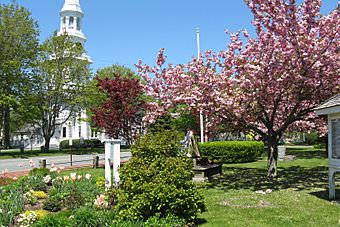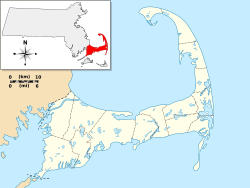Harwich Historic District facts for kids
Quick facts for kids |
|
|
Harwich Historic District
|
|

Harwich Center
|
|
| Location | Harwich, Massachusetts |
|---|---|
| Area | 55 acres (22 ha) |
| Architect | Luther and Calvin Gifford |
| Architectural style | Greek Revival, Italianate |
| NRHP reference No. | 75000245 |
| Added to NRHP | February 24, 1975 |
The Harwich Historic District is a special area in Harwich, Massachusetts. It's like a time capsule, keeping the old parts of the Harwich Center village safe. This district is famous for its beautiful old buildings. Many of them were built in the 1800s. They show off cool styles like Greek Revival and Italianate architecture.
This historic area stretches along Main Street and Parallel Street. It goes from the old cemetery on one side to Brooks Park on the other. The Harwich Historic District was officially added to the National Register of Historic Places in 1975. This means it's recognized as an important place in American history.
Contents
Discovering Harwich's Past
Harwich started a long time ago, in the 1600s. Back then, it was part of a bigger town called Yarmouth, Massachusetts. Harwich became its own town in 1694.
The Broadbrooks Family's Legacy
A family named Broadbrooks helped settle the area that is now Harwich Center. They later shortened their name to Brooks. This family was very important in building up the village. They helped create many of its buildings and businesses.
Brooks Park, at the east end of the village, was once the home of Ebenezer Broadbrooks in 1732. His house isn't there anymore. But you can still see millstones near the park entrance. These stones came from his old mill.
Sidney Brooks started a school in 1844. It later became known as the Brooks Academy. This building, built in the Greek Revival style, even served as the town's high school for a while. Sidney's brother, Henry, gave money to build the village library.
Exploring the District's Look
The Harwich Historic District mainly follows Main Street. This street runs east to west. Parallel Street runs just south of Main Street. Smaller streets connect the two. Even though it's a village, it feels a bit like the countryside. This is because of its open spaces and narrow side streets.
Most of the buildings here are made of wood. They were built in the mid-1800s. This is why you see so many buildings in the Greek Revival and Italianate styles.
Greek Revival and Italianate Styles
- Greek Revival buildings often look like ancient Greek temples. They have tall columns and simple, strong shapes.
- Italianate buildings are inspired by Italian villas. They often have low-pitched roofs, wide eaves, and decorative brackets.
One of the most important buildings is the First Congregational Church. It was built in 1832 in the Greek Revival style. Later, in 1854, it was updated. It got some new features that made it look more like the Italianate Renaissance Revival style.




